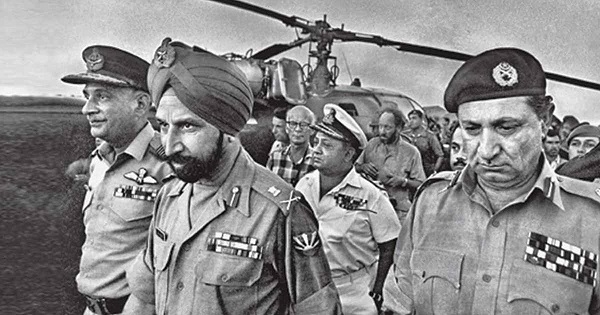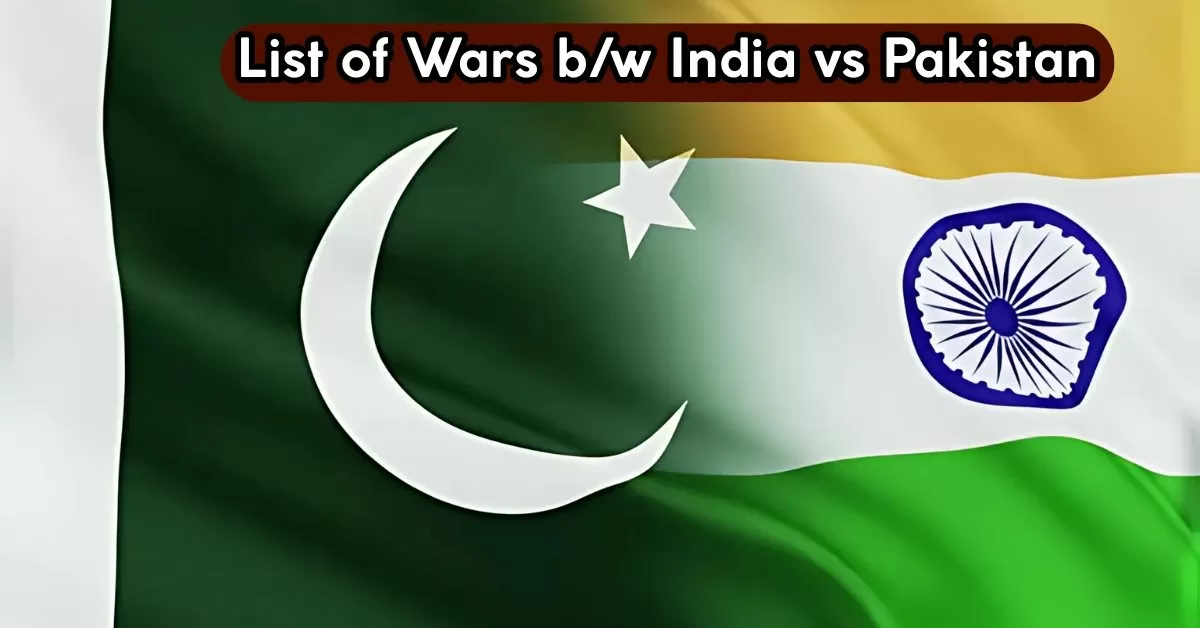India wars with Pakistan: British India gained its independence in the year 1947. However, this independence brought sorrow over joy with the partition of the country into India and Pakistan, leading to widespread violence and the displacement of millions of people.
The partition was a result of religious and political tensions between Hindus and Muslims, ultimately creating two separate nations with their own identities and challenges.
Currently, India and Pakistan have fought four times—in 1948, 1965, 1971, and 1999—and have clashed numerous times since gaining independence, most notably over the Kashmir region, which both claim.
Check Out| Comparing Rafale vs JF-17 Thunder vs F-16 Fighting Falcon: Who Holds The Upper Edge?
List of Wars Between India and Pakistan
Since gaining independence in 1947, India and Pakistan have fought four wars, with the primary point of contention being the Kashmir region. The first war in 1947-48 concluded without a clear victor. The 1965 war is still debated. India achieved a significant victory in the 1971 war, which was triggered by the Bangladesh independence movement.
In 1999, India successfully regained territories during the Kargil War. Beyond these major conflicts, the Siachen conflict (1984–2003) and the military standoffs of 2001–2002 have further contributed to the long-standing tensions between the two nations.
| War/Conflict | Year | Details | ||||||||||||
| First Kashmir War | 1947 | Started over the accession of Jammu and Kashmir; ended with a ceasefire and the establishment of the Line of Control (LoC). | ||||||||||||
| Second Indo-Pak War | 1965 | Fought for 17 days, mainly over Kashmir; ceasefire declared after Soviet and US intervention; India held a strategic advantage after countering Pakistani insurgency. | ||||||||||||
| Bangladesh Liberation War | 1971 | Sparked by Bangladesh's independence movement; Indian intervention led to the creation of Bangladesh; Pakistan suffered a major defeat with over 90,000 POWs; Shimla Agreement returned gained territories. | ||||||||||||
| Kargil War | 1999 | Pakistani forces infiltrated Indian territory; India regained control within two months through military and diplomatic efforts; significant Pakistani casualties and international pressure for withdrawal. | ||||||||||||
| Siachen Conflict | 1984-2003 | Military engagement over the disputed Siachen Glacier in Kashmir. | ||||||||||||
| 2001-2002 India-Pakistan Standoff | 2001-2002 | Tensions escalated after the attack on the Indian Parliament; a military standoff ensued, de-escalating through diplomatic efforts. | ||||||||||||
| Surgical Strikes | 2016 | India conducted surgical strikes on terrorist launch pads across the LoC in response to the Uri attack. | ||||||||||||
| Balakot Airstrikes | 2019 | The Indian Air Force conducted airstrikes on terrorist camps in Balakot, Pakistan, in retaliation for the Pulwama terror attack. | ||||||||||||
1. Indo-Pakistani War 1947-1948

Source: Borderman
The first India vs Pakistan war happened on 22 October 1947. The reason behind this war was that after independence, all the princely states were given three choices: accede to India, accede to Pakistan, or remain independent.
Raja Hari Singh, the ruler of Jammu and Kashmir, wanted to stay independent; however, due to immense pressure, the ruler signed the Instrument of Accession, which meant that J&K would be part of India. This made Pakistan send troops to Kashmir, leading to open conflict.
When Pakistani tribal armies invaded Kashmir, they took over several towns and caused a massive exodus of Hindu and Sikh refugees. The Indian army stepped in and fought to reclaim control of the territory. The battles of Uri, Baramulla, and Jammu were significant in this conflict.
2. Indo-Pakistani War 1965

Source: DefenceXP
The war started mainly due to disputes over the region of Jammu and Kashmir. Both India and Pakistan claimed the area, and tensions escalated after border clashes. Since independence in 1947, Kashmir's status has been unresolved. Pakistan supported local insurgents, and skirmishes grew into full-scale conflict.
The war lasted for about five weeks, with heavy fighting on both sides. India eventually pushed Pakistani forces back, and the war ended with a ceasefire brokered by the Soviet Union and the U.S. under the Tashkent Agreement. The ceasefire resulted in the establishment of a ceasefire line, which later became the Line of Control, but the Kashmir dispute remained unresolved.
3. Indo-Pakistani War 1971

Source: NewsBharati
The 1971 war was a major conflict between India and Pakistan. It resulted in the creation of Bangladesh. The war was mainly caused by political and ethnic tensions in East Pakistan, which is now Bangladesh.
During the war, India supported the Bengali independence movement in East Pakistan. Indian forces launched several attacks, while the Pakistani army fought fiercely. The Battle of Longewala in the western sector was a key fight where India’s forces successfully repelled a larger Pakistani army.
The war ended with the independence of Bangladesh. East Pakistan separated from West Pakistan after years of conflict. Pakistani military actions led to many atrocities and a severe humanitarian crisis.
The war had worldwide effects. The USA and China supported Pakistan, while India gained regional influence after winning. This conflict changed the politics of South Asia and worsened India-Pakistan relations for many years.
4. Indo-Pakistani War 1999: Kargil War

Source: The Indian Express
The Kargil War was a conflict between India and Pakistan fought from May to July 1999 in the Kargil area of Jammu and Kashmir. It happened because of rising tensions over the disputed region. Pakistani soldiers sneaked into Indian territory and took control of important mountain positions.
The war started when Pakistani troops and militants entered Indian-controlled Kargil and captured key strategic points along the Line of Control. The Indian army was caught off guard but quickly responded with a counterattack to take back their land.
During the war, India used air strikes, artillery, and ground attacks. The Indian Army launched “Operation Vijay” to push out the intruders and reclaim their territory. Important battles included the fight for Tololing and the recapture of Tiger Hill, which were turning points in the war.
The fighting stopped in July 1999 after the international community helped broker a ceasefire. Even though the war ended, tensions between India and Pakistan continued, and the conflict had a lasting effect on their relationship.
Unveiling Operation Sindoor: Timeline and Key Events

Source: The New Indian Express
Operation Sindoor was a major, coordinated military operation launched by India in May 2025 as a direct response to the Pahalgam terror attack of April 22, 2025, in which 26 civilians—including tourists—were killed by Pakistan-based terrorists.
The attack, perpetrated by the Resistance Front (an offshoot of Lashkar-e-Taiba), was seen as a deliberate attempt to incite communal violence and represented a significant escalation in cross-border terrorism.
Objectives and Rationale
- Immediate Trigger: The operation was triggered by Pakistan’s refusal to act against terror groups operating from its soil, despite repeated requests and evidence provided by India.
- Strategic Aim: Operation Sindoor was not intended to gain territory or provoke a full-scale war but to deliver a high-impact, punitive response targeting terrorist infrastructure and to shift the cost-benefit calculus for future cross-border attacks.
- Symbolic Naming: The operation’s name, "Sindoor", was chosen as a tribute to the victims and particularly the widows of the Pahalgam attack, emphasising the personal and national resolve behind the action.
Timeline and Execution
- Start Date: The operation commenced in the early hours of May 7, 2025.
- Duration: The main phase lasted approximately four days, concluding by May 10, 2025.
- Forces Involved: The operation was a joint effort by the Indian Army, Navy, and Air Force, with the Indian Air Force (IAF) playing a leading role in precision strikes.
Key Actions and Strikes
Phase 1: Precision Strikes on Terrorist Infrastructure
- Targets: The initial phase focused on terrorist camps and launch pads linked to Jaish-e-Mohammed, Lashkar-e-Taiba, and Hizbul Mujahideen in Pakistan and Pakistan-occupied Jammu & Kashmir.
- Scope: At least nine locations were struck, with Indian officials emphasising that only terrorist infrastructure, not military targets, was hit in the opening salvo.
- Weapons Used: The IAF deployed advanced weaponry, including SCALP (Storm Shadow) cruise missiles, HAMMER precision-guided bombs, and loitering munitions, launched from platforms like Rafale and Su-30 MKI fighters.
Phase 2: Escalation and Counterstrikes
- Pakistani Response: Pakistan retaliated with coordinated drone and missile strikes targeting over a dozen Indian military installations, including sites in Srinagar, Jammu, Pathankot, and Bhuj.
- Indian Air Defence: India’s integrated air defence systems intercepted many of these attacks, with debris confirming Pakistani origin.
- Further Indian Strikes: In response to Pakistani escalation, India expanded its campaign, targeting key military installations and airbases deep within Pakistan using air-launched cruise missiles and BrahMos stand-off weapons.
- Notable Targets: Pakistani airbases such as Bholari, Rahim Yar Khan, Sargodha, Jacobabad, and Nur Khan were hit, disabling runways, aircraft shelters, radar systems, and command centres.
- High-Value Assets Destroyed: The IAF destroyed at least six Pakistani fighter jets, two surveillance aircraft, a C-130 transport, over ten armed drones, several cruise missiles, and radar sites.
- Deep Strikes: Indian drones and missiles struck as far as Peshawar (Khyber-Pakhtunkhwa), Attock (National Defence Complex), Bahawalnagar, Gujrat, Jhang (Punjab), Chhor, and Hyderabad (Sindh), demonstrating significant reach and precision.
Phase 3: Ceasefire and Aftermath
- Duration: The intense phase of hostilities lasted about 88 hours (just under four days).
- Ceasefire: The scale of losses and operational paralysis forced Pakistan to seek a ceasefire within four days of the operation’s onset.
- Indian Message: Prime Minister Narendra Modi declared that Operation Sindoor was not a one-off, warning that any future terror attacks from Pakistani soil would be met with similar military force.
Strategic and Political Significance
- Doctrine Shift: Operation Sindoor marked a decisive shift from India’s traditional doctrine of strategic restraint to a more assertive, offensive-defence posture.
- Precision and Restraint: The operation was characterised by careful target selection, intelligence-led strikes, and efforts to minimise civilian casualties and avoid escalation into full-scale war.
- International Messaging: India underscored its commitment to upholding sovereignty and protecting civilians while signalling to the international community its willingness to act decisively against cross-border terrorism.
Key Facts of Operation Sindoor
| Aspect | Details |
| Trigger Event | Pahalgam terror attack (April 22, 2025) – 26 civilians killed |
| Launch Date | May 7, 2025 |
| Duration | ~4 days (ended May 10, 2025) |
| Main Targets | Terrorist camps, launch pads, and later, key Pakistani military infrastructure |
| Weapons Used | SCALP cruise missiles, BrahMos, HAMMER bombs, loitering munitions |
| Pakistani Losses | 6+ fighter jets, 2 surveillance aircraft, C-130, 10+ drones, radar & missile systems |
| Indian Losses | Not specified in detail; robust air defence intercepted most incoming Pakistani attacks |
| Strategic Outcome | Ceasefire within 4 days; major military and political signalling |
What's Next| List of Top 10 Best Fighter Jets in the World
